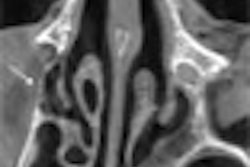Computer-aided detection (CAD) offers improvements in the diagnostic performance of radiology residents in assessing the malignancy of pulmonary nodules from thin-section helical CT scans, but does not provide the same gains for board-certified radiologists, according to research published online before print in Radiology.
"We found that when radiology residents used the CAD system, their diagnostic abilities advanced to the same level as that of board-certified radiologists who performed the assessment with or without the CAD system," wrote a research team from Kumamoto University in Kumamoto, Japan, and Fujitsu in Chiba, Japan.
To evaluate the effect of CAD in this application, the study team retrospectively reviewed the records of 171 consecutive patients suspected of having pulmonary nodules and who received thin-section helical CT between January 2002 and December 2003.
Eighteen malignant and 15 benign nodules of less than 3.0 cm in maximal diameter were ultimately included in the study. CT scanning was performed using either a LightSpeed QX/i (GE Healthcare, Chalfont St. Giles, U.K.) or a Somatom Volume Zoom (Siemens Medical Solutions, Malvern, PA).
After a radiologist identified the region of interest on a section that included a target nodule, nodule segmentation was performed automatically using a CAD system. Morphological features were quantified based on the segmentation results, and neural networks provided percentages of the likelihood of malignancy.
The study team then performed receiver operating characteristic (ROC) analysis to compare the performance of the CAD system with 10 board-certified radiologists and nine radiology residents.
Of the 18 malignant nodules, three were incorrectly diagnosed by more than three board-certified radiologists, and nine were incorrectly diagnosed by more than three radiologists, according to the study team. Five of the 15 benign nodules were incorrectly diagnosed by more than three board-certified radiologists, and seven were incorrectly diagnosed by more than three residents.
Using a threshold of 50% likelihood of malignancy, the CAD system produced sensitivity of 72.2%, specificity of 75%, and positive predictive value of 81.3%. For all 19 participants, the mean area under the best-fit ROC curve (Az) values without the CAD system was 0.843 ± 0.097 and 0.924 ± 0.043 with the CAD system, a difference that was significant (p = 0.021).
For the 10 board-certified radiologists, the mean Az value was 0.910 ± 0.052 without the CAD system and 0.944 ± 0.040 with the CAD system (p = 0.190). The nine radiology residents had a mean Az value of 0.768 ± 0.078 without the CAD system and 0.901 ± 0.036 with the CAD system (p = 0.009).
The Az value for the CAD system was smaller than that for the board-certified radiologists as a group and larger than that for the residents as a group.
"To render our CAD system useful for not only less experienced residents but also experienced board-certified radiologists, its performance must be raised to the diagnostic ability level of board-certified radiologists," the authors wrote.
The study team concluded that the use of CAD significantly improved the diagnostic performance of radiology residents but not for board-certified radiologists.
"Our future challenge is to increase the performance level of the CAD system to a level identical to, or higher than, the performance level of the board-certified radiologists," the team wrote.
By Erik L. Ridley
AuntMinnie.com staff writer
March 13, 2006
Related Reading
CAD finds breast cancers that radiologists missed for years, March 6, 2006
Mammography CAD: Getting malpractice insurers on board, October 21, 2005
CAD marks: To save or not to save? September 1, 2005
Part II: Computer-aided detection identifying new targets, July 15, 2005
Lung CAD applications starting to outread radiologists, February 13, 2003
Copyright © 2006 AuntMinnie.com




















